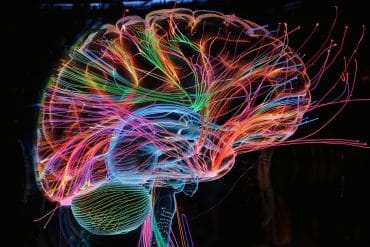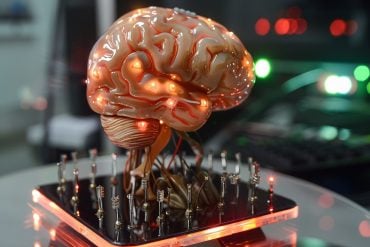Summary: A new study sheds light on how some forms of motor neuron disease begins and progresses at a cellular level.
Source: Francis Crick Institute.
Scientists have discovered how certain forms of motor neuron disease begin and progress at cellular and molecular levels, revealing potential new ways to slow down or even stop this process. The team are already working closely with pharmaceutical companies to use this knowledge to develop new treatments for motor neuron disease and other neurodegenerative conditions.
By studying cells from patients with motor neuron disease, also known as amyotrophic lateral sclerosis (ALS), the team from the Francis Crick Institute and UCL revealed a detailed picture of how motor neurons — nerve cells in the brain and spinal cord that control our muscles and allow us to move, talk and breathe — decline and die.
The research, published in Cell Reports, also shows that healthy neuron-supporting cells called astrocytes may play a role in the survival of motor neurons in this type of ALS, highlighting their potential role in combating neurodegenerative diseases. The work was co-led by Sonia Gandhi and Rickie Patani, Group Leaders at the Francis Crick Institute and UCL, and Consultant Neurologists at the National Hospital for Neurology and Neurosurgery, Queen Square.

“Understanding how and why neurons die is clearly vital in neurodegenerative diseases, but part of the puzzle is also understanding the emerging role of astrocytes in this context,” says Sonia.
The team took skin cells from healthy volunteers and patients with a genetic mutation that causes ALS, and turned them into stem cells capable of becoming many other cell types. Using specific chemical signals, they then ‘guided’ the stem cells into becoming motor neurons and astrocytes.
“We manipulated the cells using insights from developmental biology, so that they closely resembled a specific part of the spinal cord from which motor neurons arise,” explains Rickie. “It’s like changing the postcode of a house without actually moving it. We were able to create pure, high-quality samples of motor neurons and astrocytes which accurately represent the cells affected in patients with ALS.”
Using a range of cellular and molecular techniques, the team tracked motor neurons over time to see what went wrong in the patient-derived cells compared to those from healthy people. They found that an important protein known as TDP-43 leaks out of the nucleus where it belongs, causing a chain reaction that damaged several crucial parts of the cell’s ‘machinery’. Defining the sequence of molecular events that led to motor neuron death in an experiment using human-derived cells is an important step forward.
“It’s a case of the right protein in the wrong place,” says Rickie. “When TDP-43 leaves the cell nucleus, it causes a series of problems inside the cell that together lead to cell death.”
“Knowing when things go wrong inside a cell, and in what sequence, is a useful approach to define the ‘critical’ molecular event in disease,” says Sonia. By modelling the human disease in a dish, we found that this well-recognised event in ALS occurred early, and some time before the neurons showed other signs of stress. One therapeutic approach to stop sick motor neurons from dying could be to prevent proteins like TDP-43 from leaving the nucleus, or try to move them back.”
The team suspected that astrocytes from the patients’ cells might also be affected, becoming less efficient over time and eventually dying. To test this, they mixed different combinations of healthy and ALS patient-derived motor neurons and astrocytes, and followed their fate using highly sensitive imaging approaches. They found that healthy astrocytes kept sick motor neurons alive and functioning for longer, but sick astrocytes struggled to keep even healthy motor neurons alive.
“Our work, along with other studies of ageing and neurodegeneration, would suggest that the cross-talk between neurons and their supporting cells is crucial in the development and progression of ALS,” says Rickie.
Funding: The research was funded by Wellcome, Cerevance, Grand Challenges, the National Institute for Health Research (NIHR) Queen Square Dementia Biomedical Research Unit and the NIHR University College Hospitals Biomedical Research Centre.
Source: Greta Keenan – Francis Crick Institute
Image Source: NeuroscienceNews.com image is credited to Rickie Patani and Sonia Gandhi.
Original Research: Full open access research for “Progressive motor neuron pathology and the role of astrocytes in a human stem cell model of VCP-related ALS” by Claire E. Hall, Zhi Yao, Minee Choi, Giulia E. Tyzack, Andrea Serio, Raphaelle Luisier, Jasmine Harley, Elisavet Preza, Charlie Arber, Sarah J. Crisp, P. Marc D. Watson, Dimitri M. Kullmann, Andrey Y. Abramov, Selina Wray, Russell Burley, Samantha H.Y. Loh, L. Miguel Martins, Molly M. Stevens, Nicholas M. Luscombe, Christopher R. Sibley, Andras Lakatos, Jernej Ule, Sonia Gandhi, and Rickie Patani in Cerebral Cortex. Published online May 30 2017 doi:10.1016/j.celrep.2017.05.024
[cbtabs][cbtab title=”MLA”]Francis Crick Institute “Motor Neuron Disease Discovery Offers New Insights into Potential Treatment Targets.” NeuroscienceNews. NeuroscienceNews, 30 May 2017.
<https://neurosciencenews.com/als-motor-neuron-6796/>.[/cbtab][cbtab title=”APA”]Francis Crick Institute (2017, May 30). Motor Neuron Disease Discovery Offers New Insights into Potential Treatment Targets. NeuroscienceNew. Retrieved May 30, 2017 from https://neurosciencenews.com/als-motor-neuron-6796/[/cbtab][cbtab title=”Chicago”]Francis Crick Institute “Motor Neuron Disease Discovery Offers New Insights into Potential Treatment Targets.” https://neurosciencenews.com/als-motor-neuron-6796/ (accessed May 30, 2017).[/cbtab][/cbtabs]
Abstract
Dissociable Roles of Cerebral μ-Opioid and Type 2 Dopamine ReceptorProgressive motor neuron pathology and the role of astrocytes in a human stem cell model of VCP-related ALS
Highlights
•Robust and enriched motor neurogenesis and astrogliogenesis from human iPSCs
•VCP-mutant motor neurons show TDP-43 mislocalization and ER stress as early pathogenic events
•VCP-mutant astrocytes exhibit a cell-autonomous survival phenotype
•VCP-mutations perturb the ability of astrocytes to support motor neuron survival
Summary
Motor neurons (MNs) and astrocytes (ACs) are implicated in the pathogenesis of amyotrophic lateral sclerosis (ALS), but their interaction and the sequence of molecular events leading to MN death remain unresolved. Here, we optimized directed differentiation of induced pluripotent stem cells (iPSCs) into highly enriched (> 85%) functional populations of spinal cord MNs and ACs. We identify significantly increased cytoplasmic TDP-43 and ER stress as primary pathogenic events in patient-specific valosin-containing protein (VCP)-mutant MNs, with secondary mitochondrial dysfunction and oxidative stress. Cumulatively, these cellular stresses result in synaptic pathology and cell death in VCP-mutant MNs. We additionally identify a cell-autonomous VCP-mutant AC survival phenotype, which is not attributable to the same molecular pathology occurring in VCP-mutant MNs. Finally, through iterative co-culture experiments, we uncover non-cell-autonomous effects of VCP-mutant ACs on both control and mutant MNs. This work elucidates molecular events and cellular interplay that could guide future therapeutic strategies in ALS.
“Progressive motor neuron pathology and the role of astrocytes in a human stem cell model of VCP-related ALS” by Claire E. Hall, Zhi Yao, Minee Choi, Giulia E. Tyzack, Andrea Serio, Raphaelle Luisier, Jasmine Harley, Elisavet Preza, Charlie Arber, Sarah J. Crisp, P. Marc D. Watson, Dimitri M. Kullmann, Andrey Y. Abramov, Selina Wray, Russell Burley, Samantha H.Y. Loh, L. Miguel Martins, Molly M. Stevens, Nicholas M. Luscombe, Christopher R. Sibley, Andras Lakatos, Jernej Ule, Sonia Gandhi, and Rickie Patani in Cerebral Cortex. Published online May 30 2017 doi:10.1016/j.celrep.2017.05.024






